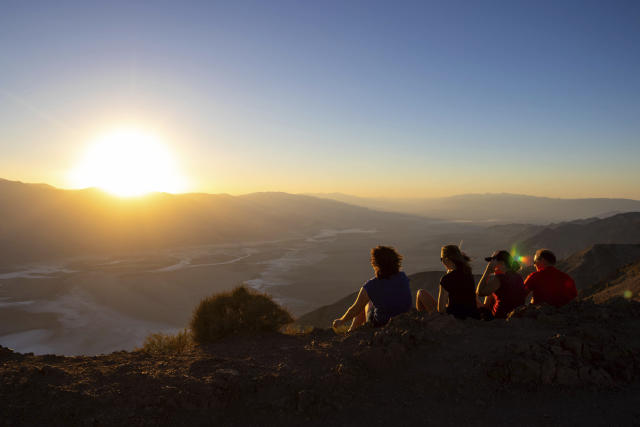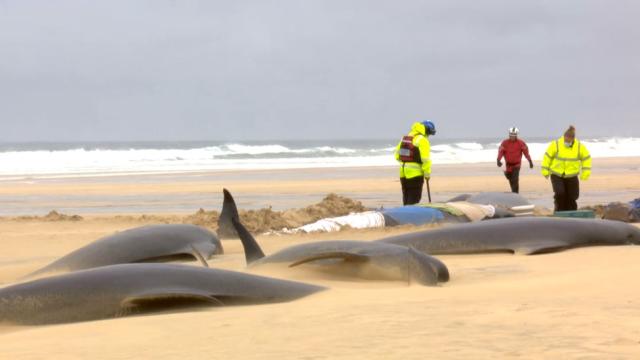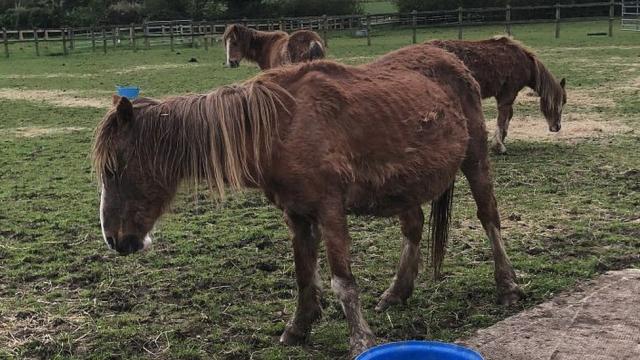Science Daily News | 17 Jul 2023

Views (98)

California's Death Valley sizzles as brutal heat wave continues
Long the hottest place on Earth, Death Valley put a sizzling exclamation point Sunday on a record warm summer that is baking nearly the entire globe by flirting with some of the hottest temperatures ever recorded, meteorologists said. Temperatures in Death Valley, which runs along part of central California's border with Nevada, reached 128 degrees Fahrenheit (53.33 degrees Celsius) on Sunday at the aptly named Furnace Creek, the National Weather Service said. The hottest temperature ever record was 134 F (56.67 C) in July 1913 at Furnace Creek, said Randy Ceverny of the World Meteorological Organization, the body recognized as keeper of world records.

Temperatures in Death Valley, which runs along part of central California's border with Nevada, reached 128 degrees Fahrenheit (53.33 degrees Celsius) on Sunday at the aptly named Furnace Creek, the National Weather Service said.
“With global warming, such temperatures are becoming more and more likely to occur,” Ceverny, the World Meteorological Organization’s records coordinator, said in an email. “Long-term: Global warming is causing higher and more frequent temperature extremes. Short-term: This particular weekend is being driven by a very very strong upper level ridge of high pressure over the Western U.S.”
On Sunday in Death Valley, meteorologists were tracking high clouds in the area that could keep temperatures in check.
“The all-time record seems fairly safe today,” said Matt Woods, a meteorologist with the National Weather Service's Las Vegas office, which monitors Death Valley.
Residents in the western U.S. have long been accustomed to extreme temperatures, and the heat appeared to prompt minimal disruptions in California over the weekend. Local governments opened cooling centers for people without access to air conditioning to stay cool. The heat forced officials to cancel horse racing at the opening weekend of the California State Fair as officials urged fair-goers to stay hydrated and seek refute inside one of the seven air-conditioned buildings.
Death Valley dominates global heat records. In the valley, it’s not only hot, it stays brutally warm.
The two hottest temperatures on record are the 134 F in 1913 in Death Valley and 131 F (55 degrees C) in Tunisia in July 1931. Burt, a weather historian for The Weather Company, finds fault with both of those measurements and lists 130 F (54.4 C) in July 2021 in Death Valley as his hottest recorded temperature on Earth.
“130 degrees is very rare if not unique,” Burt said.
There are other places similar to Death Valley that may be as hot, such as Iran’s Lut Desert, but like Death Valley are uninhabited so no one measures there, Burt said. The difference was someone decided to put an official weather station in Death Valley in 1911, he said.
Scientists such as Vose say that most of the record warming the Earth is now seeing is from human-caused climate change, partly because this El Nino only started a few months ago and is still weak to moderate. It isn’t expected to peak until winter, so scientists predict next year will be even hotter than this year.
___
Borenstein reported from Washington and Beam reported from Sacramento, California.
__
__
Isle of Man sends digital stamps on data storing mission to the Moon
A set of stamps is being sent to the Moon on a mission to explore how data centres work in space.

Digital Manx stamps are to be sent to the Moon on a mission to discover how data centres work in space.
Digital Isle of Man and space data storage company Lonestar are taking part in NASA's Commercial Lunar Payload Services programme.
It aims to explore how data could be stored on the Moon and retrieved should a catastrophe take place on earth.
Enterprise Minister Tim Johnston said the island was building on its "history of innovation in the space sector".
The possibilities this technology could bring were "hugely exciting", and the project was an example of the island participating in "pioneering new developments for businesses", he said.
A government spokeswoman said the initiative was using expertise in the island's blockchain industry to "digitise exclusive stamps that will be posted to the Moon and back" via Lonestar's lunar data centre.
Lonestar CEO Chris Stott said he felt "enormously privileged to be able to run such a novel mission from my home".
He said: "We could not do this without the island and its unique commitment to disaster recovery, space, and the global digital economy."
The government spokeswoman said the digital stamps, which each feature a different version of the triskelion flag, would be verified and tracked on the return trip to the Moon, and the trail would become part of a digital footprint.
They would then be transmitted back to the Earth as part of the larger Artemis lunar exploration programme mission, she said.
Entire pod of 55 whales dies after mass stranding on Lewis
Just 15 were alive after the stranding and vets had to euthanise the survivors on welfare grounds.

An entire pod of 55 pilot whales has died after a mass stranding on a Western Isles beach.
Only 15 were alive after they washed onto Traigh Mhor beach at North Tolsta on the Isle of Lewis at about 07:00 on Sunday morning.
Marine charity British Divers Marine Life Rescue (BDMLR) attempted to refloat one of the more active whales but it was then restranded.
The decision was taken to euthanise the remaining whales on welfare grounds.
Western Isles Council - Comhairle nan Eilean Siar - has asked people to avoid the area as a clean-up operation began.
This led them to suspect that the whole pod stranded due to one female giving birth.
Pilot whales are known for their strong social bonds, so often when one whale gets into difficulty and strands, the rest follow.
Attempts continued throughout the day to give the surviving whales first aid.
But after the attempt to refloat one of the whales, it was found further down the beach.
A further three whales then died, leaving 12 still alive - eight adults and four calves.
A statement said: "At about 15:30, the local vet along with the Coastguard, Fire and Rescue, and a forensics vet came to the conclusion that the shallow beach and rough wave conditions made it too unsafe to refloat the remaining animals.
"Considering how long the pilot whales had been out of the water in addition to the poor conditions, it was decided that they should be euthanised on welfare grounds."
Members of the Lewis community, Stornoway Coastguard, Stornoway and Shawbost Fire and Rescue, the Scottish Marine Animal Stranding Scheme (SMASS), the Scottish SPCA, and Civil Air Support were all involved in the rescue effort, with vets and marine experts being flown in to help.
SMASS will now carry out post mortem examinations of the bodies to conclude the cause of the stranding.
Pilot whales are small whales characterised as part of the dolphin family.
Earlier BDMLR's Welfare and Conservation Director Dan Jarvis told BBC Scotland that the longer the whales were on the beach, the less likely it was that they would survive.
He said: "They have evolved to not have the ability to support their own weight on land. So when they are stranded they can crush themselves to death.
"Pilot whales don't usually come in to shore. They would be potentially disoriented, distressed from what has led to the stranding, and distressed from the stranding itself and being surrounded by family members who have died around them.
"This is one of the biggest incidents we've had in the last couple of decades."
A Comhairle spokesperson said: "Comhairle nan Eilean Siar asks that the public follow police advice and avoid Traigh Mhòr.
"The Comhairle has engaged with professionals and is now working with partner organisations to clear the beach."
Farm fields don't just feed us. They store carbon. But a big question is how much
When Al Schafbuch cut back on plowing his Iowa fields decades ago and later began growing cover crops, he was out to save money on fertilizer and reduce erosion. There's one more big payoff that benefits everyone: tilling the soil less, and growing more cover crops, can help farmers store more planet-warming carbon in fields. More plants take in more carbon dioxide, and soil microbes breathe out less carbon when undisturbed.

DYSART, Iowa (AP) — When Al Schafbuch cut back on plowing his Iowa fields decades ago and later began growing cover crops, he was out to save money on fertilizer and reduce erosion. He got those benefits and saw his soil change for the better, too: dark, chunky, richly organic matter that he said feels like “chocolate cake."
There's one more big payoff that benefits everyone: tilling the soil less, and growing more cover crops, can help farmers store more planet-warming carbon in fields. More plants take in more carbon dioxide, and soil microbes breathe out less carbon when undisturbed. That can mean money for participating farmers in the form of carbon offsets — payments that companies can make that support carbon storage in farms and, in theory, balance out their emissions elsewhere.
“The more carbon you store from the atmosphere with your crops, and the more crops grown throughout the year, you offset some of your waste, your wasted energy,” said Shalamar Armstrong, an associate professor of agronomy at Purdue University. “Because you’ve stored carbon that would have been emitted (into) the atmosphere.”
“The science piece (of carbon credits) has really lagged behind, particularly when it comes to things like monitoring, reporting and verification,” said Cristel Zoebisch, deputy director of policy at climate organization Climate 180. “These are huge obstacles for not just soil carbon sequestration, but really any land-based carbon removal solution.”
Armstrong has been trying to help fix that problem. He runs a lab where researchers are investigating how farming management affects the amount of carbon in soil across different landscapes. He and others at Purdue have been studying soil samples that date back more than 40 years, comparing different types of tilling and cover crops to determine their long-term effects on carbon storage. It can take years of fieldwork, careful chemistry in the lab and lots of expensive equipment to puzzle that out.
He hopes his precise calculations will help farmers make decisions that allow them to receive worthwhile incentives for sequestering carbon while maintaining their existing profits.
But other academics worry that even if farmers do get paid for storing soil carbon, it won't solve a bigger problem: that carbon markets often don't work.
For offsets to be legitimate, they have to meet four criteria. They have to store carbon that would otherwise be emitted; they have to be verifiable in data; they have to be immediate (planting a tree that might grow up in 20 years doesn't cut it); and they have to be long-lasting, said John Sterman, a professor of management at Massachusetts Institute of Technology.
Better quantifying soil carbon storage through research might make the offsets more verifiable, but it doesn't address other factors. For example, many farmers rent the land they work, and can't guarantee that carbon stored on their land will stay put in several decades if someone else is working the land.
Barbara Haya, director of the Berkeley Carbon Trading Project at University of California, Berkeley, has worked on research that she said shows the effects of carbon offset projects are commonly overestimated, sometimes vastly so.
“Carbon trading is a mechanism that has failed miserably over the last 20 years that we really need to be moving away from," Haya said.
U.S. Rep. Jared Huffman, D-Calif., last month introduced a bipartisan bill to support farmers in improving soil health, with incentives that don't necessarily involve the carbon market. He said farmers in his district have also described the benefits of regenerative practices, and that many would be interested in participating in carbon markets with “robust” accounting systems. But he added that those hoping for serious climate action shouldn't rely only on offsets.
“In my opinion, it’s really not the silver bullet,” Huffman said. “I think offsets are inherently sketchy."
Some farmers are moving cautiously.
Brad Wetli, an Indiana farmer who collaborates with Armstrong, has been trying techniques that use less tilling and has been planting cover crops like rye for a few years now. He's happy with the way his current fields look — “It feels like you're doing something” to contribute to sustainability, he said — but he's still weighing his options with possible carbon credit contracts, doing the math and waiting to see whether the price will be right, since many offset agreements can last for several years.
“I’m going to do maybe a field or two at a time, and as I learn more, I’ll hopefully incorporate the carbon or carbon credits more into the operation,” he said.
Schafbuch, for his part, is skeptical of carbon credits but would have been enthusiastic about regenerative farming no matter the upfront costs. He said he was an early adopter in the face of neighbors who laughed and suggested he would “end up being broke” — but he’s proved them wrong.
“I’m convinced that if you do it right, anybody can do it," he said.
___
Associated Press journalist Joshua Bickel contributed to this report from Fowler, Indiana.
___
___
Gelligaer: Ponies found in 'terrible' condition are rescued
The animals were "terrified of humans" when found but are expected to make a full recovery.

A group of ponies who were rescued after being found in "terrible" conditions are expected to make a full recovery.
The animals were found on Gelligaer Common, which spans the counties of Caerphilly and Merthyr Tydfil.
The HorseWorld charity said the ponies were "running wild" on common land with "no sign of anyone caring for them".
The case was investigated for a possible prosecution, but no owner could be traced.
HorseWorld said it worked with other charities to rescue 25 ponies in total from the common, before bringing five of them - now named Pretzel, Peanut, Pumpkin, Peaches and Plum - to live at their site in Bristol.
The charity said there had not been enough grazing to sustain the animals.
A spokesperson for Caerphilly council said neither it nor Merthyr Tydfil council had responsibility for the horses.
Sarah Hollister, head of equine welfare at HorseWorld, said: "The positive news is all five ponies are doing really well now and are expected to make a full recovery."
She said her team had started some "very gentle" rehabilitation training with the ponies to help them get used to being handled.
Ms Hollister added: "For ponies like this, that have likely never had human contact, we start with a glove on a pole and slowly get them used to being touched with the trainer remaining at a comfortable distance for them.
"As they accept this, we can move a little closer. This is a long slow process which is never rushed, it takes as long as it takes. The welfare of the horses, their comfort and happiness, is paramount."
The charity said it could take years for the ponies to be fully trained and ready to embark on the new lives ahead of them.
It added: "Whatever lies ahead, once a horse or pony comes into HorseWorld's care we guarantee they have a home for life.
"They are safe for the rest of their lives."
Super-close supernova captivates record number of citizen scientists
Data from the closest cosmic supernova explosion to Earth for 10 years was collected by a record number of observers for SETI, showing what the collective power of citizen scientists can achieve.

The closest cosmic explosion to Earth in the last 10 years became a record breaker for the Search for Extraterrestrial Intelligence (SET) Institute.
The effort involved 123 dedicated amateur astronomers making 252 observations with 115 telescopes following how light from the supernova changed over time, first seeing its escalating brightness and then tracking its gradual fading. This allowed the SETI scientists to build a profile for the supernova that astronomers called a light curve, a measurement of its brightness over time.
RELATED STORIES:
Participants receive real-time alerts when transient events are spotted, resulting in the rapid initiation of observing campaigns such as the one seen for (SN) 2023ixf. As they monitor the increase in brightness and subsequent fading of cataclysmic events, volunteers help scientists to gather vital details about the objects behind these violent and powerful celestial occurrences and their impact on surrounding gas and dust, known as interstellar material.
The program will get a major boost next year when the Vera C. Rubin Observatory in Chile commences operations, allowing the Unistellar network of citizen astronomers to team up with other crews of astronomers and professional astronomers to study transient events.
0 Likes
